Our second nForce 650i SLI motherboard in our labs.
We will see how it will do compared to the MSI P6N-SLI Platinum.
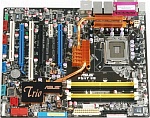
Features:
nVidida 650i SLI MCP/570i SLI MCP
8-phase VRM
VIA VT6308S Firewire controller
Realtec ALC888
2x Marvell 88E1116 network PHY
1x Silicon Image SIL3135 PCIe SATA II
ITE IT8718F-S Super I/O controller
1x NEC µPD720404 PCIe x4 to PCI-X 133MHz bridge IC
passive cooling of chipsets
8Gb BIOS, version 0305
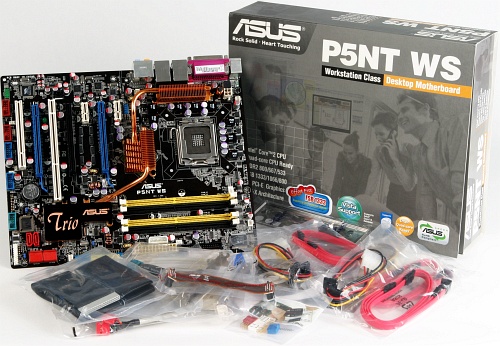
Slots:
2x PCIe x16, 1x PCIe x16 @ x1 speed
2x PCIe x1
1x PCI-X 133MHz
1x PCI
Memory:
2x Dual-Channel DDR2-slots for PC2-4300U/PC2-5400U/PC2-6400U memory up to 8GB
Storage:
6-Port SATA II featuring RAID 0, 1, 5, 0+1, JBOD
1-Port eSATA II
1-Port IDE
Backpanel ports:
1x PS/2 keyboard
1x PS/2 mouse
1x parallel port
1x eSATA II
2x Gb LAN
1x Firewire
4x USB 2.0
7.1 Audio analog
1x SP/DIF digital out
1x SP/DIF coaxial out
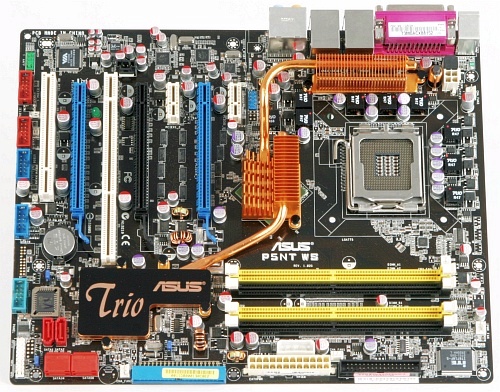
Accessories:
1x 2-port Firewire bracket
1x 2-port USB bracket
6x SATA cable
3x HDD-power to 2x SATA power cable
1x Floppy cable
1x IDE cable
1x 1-port serial bracket
1x SLI Bridge
1x ASUS Q-Connetor Pack
BIOS features:
Bus Speeds: Auto, 533 to 3000 (133~750MHz) in 1MHz increments
Memory Ratios: Auto, Linked, Unlinked
Memory Speed: Auto, Manual, 400-2000MHz
PCIe Speeds: 100MHz~200MHz in 1MHz Increments
CPU VCore: 0.93125V to 1.70000V in 0.00625V increments
CPU Clock Multiplier: Auto, manual
Core 2 Duo: 6x-11x in 1X increments - Core 2 Duo, downwards unlocked
Core 2 Extreme: 6x-16X, downwards unlocked
DRAM Voltage: 1.800V to 2.575V in 0.025V increments
NB Voltage: 1.20V to 1.55V in 0.05V increments
SB Voltage: 1.500V to 1.750V in 0.025V increments
NB<->SB HT Voltage: 1.20V to 1.55V in 0.05V increments
CPU VTT: 1.20V to 1.50V in 0.10V increments
SB Standby: 1.50V to 1.80V in 0.10V increments
Layout:
ASUS P5NT WS is of course an "all-solid" design, which was expected at an €200,- price target. Instead of using the 430MCP, ASUS decided to use the older nForce 570i SLI chipset. The only benefit compared to similar boards is SLI in x16 mode for both cards. Of course the 570i SLI is more power-hungry.
The power-voltage-regulator is a 8-phase analogue part, we would have wished for an digital VRM. The power-connector is positioned under the memory slots. The 8-pin CPU-power connector is well placed on the outer edge next to the cpu socket. The CPU area is clear, mounting big coolers is easy.
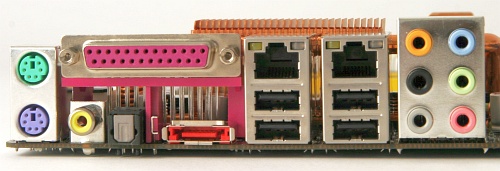
The colour-scheme is quite pleasing, black PCB on the front, dark-blue PCB on the back. Dual Channel memory is easy identified with the yellow and black memory slots.
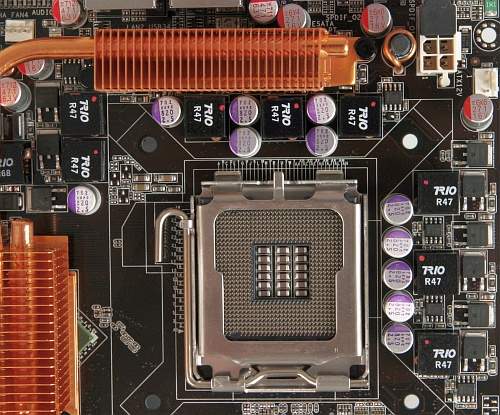
nForce 570i SLI supports six SATA II ports and one IDE. An extra SATA port is provided by the Silicon Image controller, but for eSATA only. Four of the SATA ports and the IDE port are angeled 90°, this should help with the cable mess.
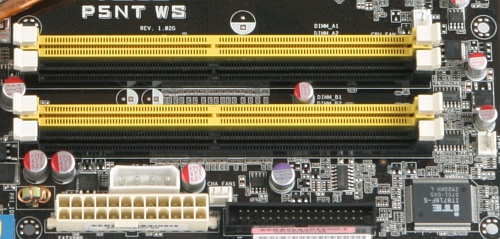
Network connectivity is provided by two Marvell 88E1116 PHY, each MAC of the chipsets are utilized. Additional a VIA VT6308S firewire controller is integrated. Very odd for an ASUS highend board, this one comes with an Realtek ALC888 instead of an Analog Devices ADI1988B.
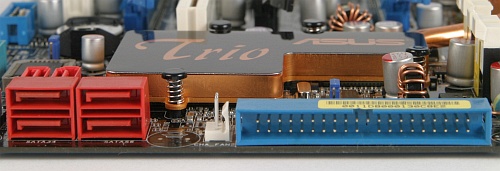
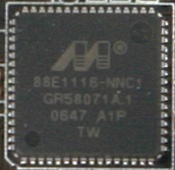
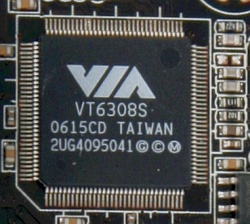
The panel-connectors are not colour-coded, but ASUS provides Q-connectors. You can assemble all cables to the Q-connectors and put them later into the board.
While other SLI boards needs a PCIe switch card, ASUs does not, because it has two chipsets, means that the x16 from 650i and 570i do the SLI without any performance loses. nVidia is using Hypertransport to connect its chipset and of course any board manufacture can combine any chipset with Hypertransport they want.
The configuration of the slots is not perfect, using a SLI configuration you will loose the only PCI slot.
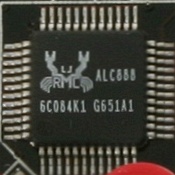
The heatpipe-construction can barely keep the temperature of the 650i SLI low. It also covers only three of the eight phases. ASUS did use heat-pads instead of a better thermal compound. There is no chipset fan inclucded, so good case-cooling is paramount.
Testbed:
Motherboard:
ASUS P5NT WS (provided by ASUS)
nForce 650i SLI SPP/570i SLI
CPU:
Intel Core 2 Duo E6700 (provided by Intel)
CPU-Cooler:
Scythe Andy Samurai Master (provided by Scythe-Europe)
Memory:
Kingston 2GB PC2-9600U Kit KHX9600D2K2/1G (provided by Kingston)
CL5-5-5-15-CR2T at 1.80V
CL4-4-4-12-CR1T at 2.20V
Graphics Card:
AMD ATI Radeon X1950XTX (zur Verfügung gestellt von AMD)
Power supply:
Silverstone Element SF50EF-Plus (provided by Silverstone)
Hard disk:
Seagate Barracuda 7200.9 500GB SATA (provided by Seagate)
Case fans:
SilenX iXtrema Pro 14dB(A) (provided by PC-Cooling.at)
Scythe DFS122512LS
Chipset:
The successor of nForce 570i SLI is faster, the ASUS board is sometimes faster with CR2T compared to the MSI P6N-SLI Platinum with CL4-4-4-12-CR1T settings, especially with very high CPU-clocks. CR1T was not possible with higher clocks then 800MHz, some benchmarks will crash. The same downside comes to the chipset-cooling compared to the P6N-SLI. Temperatures do easily exceed 60°C especially during overclocking, but ASUS doesn't provide any additional fans, to cool it down.
BIOS:
ASUS has choosen an AMI BIOS, which looks still beta. The CPU multi won't work on our CPU, it shows correct frequency on boot up, but does boot with full multi. So we could not test FSB 400 or more. The overclocking settings are in different menues, standard for ASUS, but user-unfriendly. The rest is fairly common nothing special.
FSB overclocking:
As mentioned above, without a lower multi, we where not able to check out how high the FSB can go. We tried the usual 373MHz, which worked fine, but the CPU was not stable to complete our benchmarks. The same CPU was used with the MSI P6N-SLI Platinum where all benches worked.
memory overclocking:
The board worked with 1000MHz but did not boot up with our rated 1200MHz kit. The CR1T setting is not possible with clocks above 800MHz, synthetic benches do work, but Gordian Knot/XVID is always crashing.
CPU overclocking:
Due the BIOS multi-bug we could only reach stable 3666MHz, but we doubt we would have reached more. The worst problem ist the VRM. "Eight-phases" sounds cool, but that's it. The VDrop was above Intel specifications of 5mV. While the MSI run the 3666MHz with a VCore of 1.5000V, ASUS needed 1.53750V. As you can see VCore drops to 1.472V. This is not exactly the voltage, because the sensor is only able to give 8mV granulars, even when you can set the VCore in 6.25mV steps.

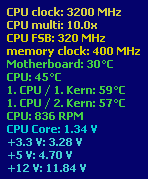
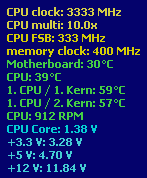
Benchmarks:
We didn't bother with synthetic benchmarks, because they won't tell you anything interesting, we concentrate on real world applications, especially multimedia encoding. Everest will report above 9300MB/s and SiSoft above 7200MB/s when benching memory-read, nobody has explained yet, while there are differences in the results.
Gordian Knot/XVID 1.1.2:
For our Gordian Knot testing we took an PAL epsiode from "Babylon 5" with a length of 41 minutes, 57 seconds and 8 frames.
We tried to "emulate" the most common usage of Gordian Knot:
1st: We have a perfect master, so we only de-interlace the content and resize it, without any other manupulations, we marked this as "fast".
2nd: You get bad mastering on many DVDs, especially "old" stuff or when the studios are in a hurry for the release. In this case you like to improve the picture quality, which is done by filtering the content. You can choose from tons of filters for any purposes you can think of, we only used the most common "undot", "FluxSmooth" and "MSharpen". Of course we also de-interlaced, filters were done before any resizing took place (which is slower). We marked this as "slow".
If you need more infos about filters, we recommand reading the doom9.org forum.
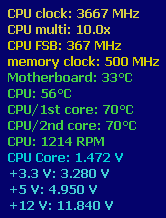
LameMT:
The same episode we encoded, we used for our MP3-testing. We don't recommand using MP3 for encoding, because AC3 can do the job better, but nearly 42 minutes gives us approximately the length of any given album.
A measurement in seconds, as many sites do, is useless, because the differences are too small. So we used the built-in play/CPU ratio, this means the CPU is encoding x-times faster then the track-length. Fast memory does not play an important role here. For your convenience we show you also the single-threaded benches, they will be produced with any other L.A.M.E. version, because only lameMT can do more than one thread and take advantage of a second dice.
We used this setting: lamemt --vbr-new -q 2 -V 2 -m j --strictly-enforce-ISO --resample 48
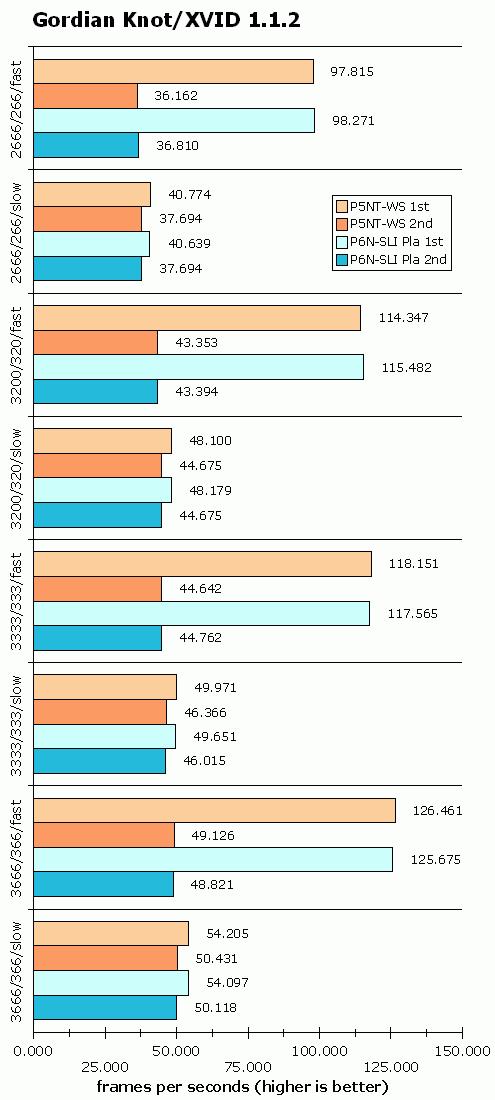
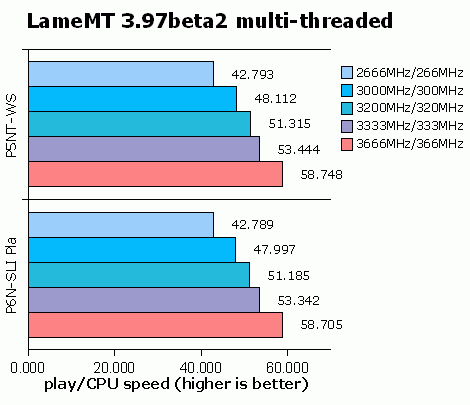
Power-Consumption:
Using the ASUS P5NT WS gives you a power penalty of some watts, especially when you will overclock higher. Also the "Southbridge" which is defacto a single-chip chipset will add to the penalty. Of course the consumption will vary if you use other equipment.
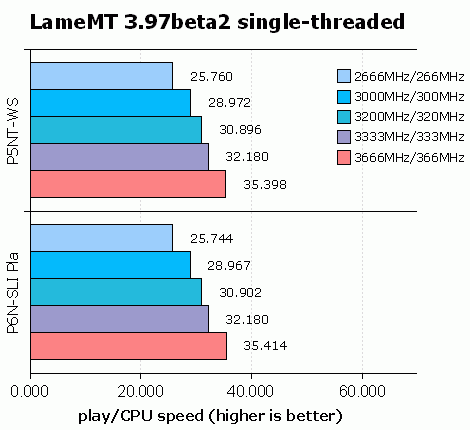
Conclusion:
If workstation is an issue for you, needing SLI and PCI-X than you don't have much choice. When PCI-X is no use for you, choosing an other board is wise. While the difference between x8 and x16 is only a couple of frames, such boards are much cheaper. The issues with the VRM also is a reason not to purchase this board. We got in contact to ASUS and asked if this is just an BIOS-issue or a bad design, because we have seen such behaviour also on the newly P5K board. When ASUS provides an answer, we will update this article and let you know. Compared to the MSI P6N-SLI Platinum the price is too high.
The ASUS P5NT WS is selling for about €195,-.

